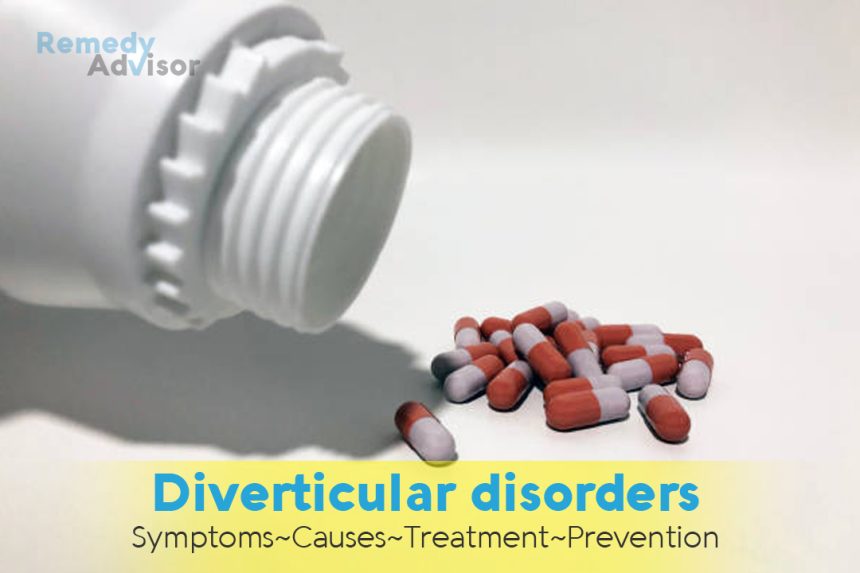What is it
Diverticulosis is a condition, not a disease. It occurs when tiny grape-size pouches (diverticula) form in the stomach or intestine, typically along the lower wall of the colon (large bowel). These are small, self-contained pouches that often produce no symptoms, and typically are discovered only by an x-ray or intestinal examination for an unrelated problem.
According to the National Institutes of Health, 1 in 10 people over 40 and half those over 60 have diverticulosis. Though the condition is common, most people who have it never know, since they experience no symptoms. However, the condition is associated with irritable bowel syndrome^ which may cause such symptoms as gas, bloating, and diarrhea. And if your diverticulosis-w turns into diverticulum; as happens with some people, you will definitely have symptoms. Diverticulitis occurs when one or more of the pouches becomes infected from bacteria in the digestive tract, usually because a particle of undigested food gets trapped in the pouch. An over- growth of bacteria subsequently occurs, producing inflammation.
A mild infection can produce bloating, gas, and nausea, and most people don’t immediately see a doctor for these symptoms, especially if they improve. (Pain is usually on the left side of the abdomen, unlike appendicitis, which affects the right side.) But some symptoms abdominal pain and/or rectal bleeding are severe and shouldn’t be ignored. They can be signs of complications. An abscess may develop and the intestinal wall may become perforated, causing surrounding tissues in the abdominal cavity to become infected. These cases, fortunately rare, can be life-threatening and call for immediate hospitalization, and possibly surgery.
Symptoms
Diverticulosis
- In most cases there are no symptoms.
- Some people develop mild cramping or tenderness in the left side of the abdomen, which disappears after a bowel movement or passing gas. Nausea, gas, and constipation are also occasional symptoms.
- Rarely, flecks of bright red blood appear in the stool.
Diverticulitis
- The most prominent symptom is intermittent lower left abdominal cramping (or tender- ness or acute pain) that usually appears suddenly and may be mild to severe. The discomfort may stop and then recur, or it can become chronic.
- During attacks, fever may occur, accompanied by chills and nausea.
- Constipation is common, diarrhea is less common.
- In some instances rectal bleeding occurs, as does bowel obstruction.
- Rarely, breaks and leaks in the bowel wall occur, typically between the colon and the bladder. This is signaled by bladder irritation and the passing of fecal matter and gas in the urine.
What causes it
Exactly why diverticulosis occurs isn’t known, but it appears to be caused by excess pressure within the colon that pushes the diverticula through the intestinal muscle. This pressure buildup gets worse with age.
Research done on different populations suggests that a lack of fiber in the diet is associated with diverticulosis. The condition occurs most frequently in industrialized societies, where fiber intake tends to be low. It is rare in regions (such as rural Asia and Africa) where the diet is high in fiber. Fiber helps soften stools so they move more easily through the colon; hard stools require the colon to exert more pressure, which may lead to the formation of diverticula.
What if you do nothing
For most people, diverticulosis poses no problems, and mild flare-ups, with symptoms of abdominal distress, often clear up with no special measures taken. Diverticulitis cannot be ignored because an inflamed diverticulum may rupture and cause a life-threatening infection.
Home remedies
Diverticulosis is rarely a problem for most people, but you can take measures to prevent the condition or to prevent existing diverticula from becoming inflamed, as explained below. Treatment for diverticulitis generally consists of bed rest, a liquid diet, and antibiotics to combat the infection. (Some patients with severe or multiple attacks about 15 to 30 percent may require hospitalization and surgery.)
Prevention
The best way to reduce your odds of developing diverticular problems is to avoid constipation and straining during bowel movements. Perhaps because fiber used to be called roughage, the idea used to be common that a high-fiber diet fruits, grains, and vegetables-was somehow rough on the bowels and that a person with symptoms of diverticulitis should immediately go on a low-fiber or even a liquid diet. It’s now thought that this is about the worst thing you can do. Indeed such a diet can even cause the large intestine to go into spasm.
Fiber, on the other hand, provides bulk in the intestine when the fiber is consumed with an adequate amount of fluid, and this enables food and waste to pass more easily and efficiently.
Of course, if you have an acute case of diverticulitis requiring hospitalization, you may have to follow a liquid diet and take antibiotics until your colon has begun to heal. Soon after, though, you will be advised to increase your fiber intake.
Here are steps you can take to keep diverticulosis “silent.”
Eat a lot of fruits, whole grains, and vegetables
To boost your fiber intake. (If you aren’t used to a high-fiber diet, start gradually.) Choose whole-wheat bread over white, brown rice over white. Add a little bran to baked goods. Eat whole-grain cereals for breakfast. Eat fruits and vegetables unpeeled when you can. Raw produce is good, but cooking does not destroy fiber.
Drink plenty of fluids
At least eight-eight-ounce glasses of fluids daily, including juices and soups. Fruits and vegetables also contain a high percentage of water, which is another plus.
Get regular exercise
There is some evidence that physically active people are less prone to diverticulitis and that exercise may help prevent constipation.
Eat a few prunes
For occasional constipation. They are not only a good source of fiber but also contain a natural laxative. Don’t rely on stimulant laxatives.







